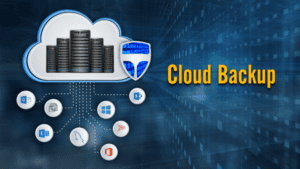The availability and reliability of systems, servers, databases and applications for a business’s customers and employees is essential. You run the risk of experiencing major operational disruptions, if your systems were to ever undergo any kind of downtime and you neither have system or server backups nor have a disaster recovery plan in place.
Imagine going to your favourite retail store and having to spend triple the amount of time on the queue at the till, than you usually do, because their Point of Sale (POS) system is down.
Both customer and employee satisfaction would definitely take a major hit.
In this article, we’ll explore:
Debunking cloud backup
What it is ✅
Cloud backup and recovery, also referred to as ‘online backup’, ‘server backup’ or ‘remote backup’ is a cloud service in which the data and applications on a business’ servers, are copied and stored in an alternative location, for preservation in case of equipment failure, site catastrophe or human malfeasance.
The backup server and data storage systems are usually hosted by a third-party cloud or SaaS provider, that charges based on storage space (capacity used), data transmission bandwidth, number of users, number of servers or the number of times the data is retrieved.
What it’s not ❌
Cloud technology, albeit coming to be a norm, is yet to be fully accepted, due to some misconceptions that paralyze its adoption.
Let’s debunk some of the most popular ones below.
Misconception 1: Cloud backup is not secure
There is a deep-rooted fear and uncertainty when it comes to the security of data hosted on the cloud.
Cloud backups are generally more secure against ransomware attacks because they are performed outside of the business’s network. The concept that the cloud is much less safe comes from a space of perceived loss of control. However, with Google Cloud, you in fact acquire more control over your data than you have in your own on-premise atmosphere.
By leveraging Google Cloud’s Identity and Access Management (IAM) service, users can manage access to their data by defining what users and services, can access the backed-up data resources.
Misconception 2. “Cloud backup is the same thing as cloud storage.
Cloud backup is basically about two files. One on your primary server and another stored elsewhere. The difference all comes down to the usage of the files. Are you looking to keep those files on your server or do you want to outsource them to free up disk space storage?
Types of Cloud Backup
Here, we will explore off-site cloud backups, where your data is stored at a secondary cloud-based data centre that is guarded with layers of protection, undergoes regular server backups and can easily scale to meet your business needs.
Private cloud
Also known as an internal or enterprise cloud, it is used by one organization and is not exposed to the public. The cloud itself is situated inside the organization and is protected by a firewall to ensure only the organization and its users have access to the data.
Public cloud
Public cloud is cloud computing that utilizes an independent third-party, such as Google Cloud, Amazon Web Services or Microsoft Azure, to host, manage and maintain the storage of your data in a multi-tenant environment that shares resources with other clients in the cloud. By pooling resources, the public cloud can offer affordable, pay-as-you-go online data storage that can easily scale to meet your business needs.
NB: The cloud service provider provides the hardware and ensures its operationality.
Hybrid cloud
Utilizes both private and public cloud services, with a management platform that spans these environments allowing data and applications to be shared between them and on-premise storage.
Why would I need to back up my servers and systems?
Since most servers are generally reliable, it’s easy to underestimate how important it is to back up your servers. Backup of vital company information is critical to a company’s survival, no matter the size of the company.
Here are the main reasons why backing up your server/data/systems is the most sensible thing to do.
- Increased competitive advantage
Access to all your data, all the time, is the prerequisite to successfully competing by responding faster, more proactively and more knowledgeably. More importantly, you achieve a significant competitive advantage by freeing up valuable staff resources for other projects that have a more direct impact on your productivity and profitability.
- Increased competitive advantage
- Freedom from Routine Backup and restore tasks
The unpleasant reality is that many traditional backup and recovery methods are time-consuming and tedious. And while businesses know they must protect their data, those with limited technical staff would prefer to focus their time on more strategic, value-driven projects rather than monitoring the progress of manual backups, reviewing logs and troubleshooting problems.Online backup and recovery solutions reliably and automatically offload these functions, freeing staff for work that has a more direct impact.
- Freedom from Routine Backup and restore tasks
- It is highly scalable
A key advantage of cloud backup is that you can back up as much or as little data as you want. Your service will adapt as your capacity requirements expand, and this is done on demand.With cloud backup, you also only pay for what you need. This avoids the unnecessary purchase of extra hardware and software for storing your growing volume of backup files.
- It is highly scalable
- Immediate data restoration
Businesses run in real time and rely on electronic data: anything from payroll and customer files, to email and other important documents. When disaster strikes, you don’t have the luxury of waiting hours upon hours to restore your data.The best online backup and recovery services transmit only changes in files and databases — a highly efficient approach that optimizes fast recovery, particularly in cases of data corruption, one of the most common causes of data loss.
- Immediate data restoration
- Comprehensive and reliable data protection
A number of cloud-based storage solutions and modern backup solutions boast strong security measures. In-transit and at-rest encryption, zero-trust security models, etc. can offer enhanced data protection. - Enhanced ability to demonstrate compliance
Today, most industries are adopting their own ever-changing regulations governing offsite data protection and retention periods. Since fully half of companies that lose their data in a disaster go out of business as a result, most companies recognize their fiduciary responsibility to protect critical data assets.Another benefit of outsourcing server data protection is that the best solutions help you demonstrate consistent, repeatable processes and controls around information protection. The same Web-based management tools that make it easy for you to manage and monitor backup and recovery also allow you to control archive requirements that ensure compliance with corporate and regulatory guidelines.
- Comprehensive and reliable data protection
Some notable benefits:
- Manage your backups and restores all in one place.
- Eliminate downtime with on-demand, instant recovery.
- Reduce space required for storing backups as it only stores incremental changes.
Read more: Google Cloud Backup and Recovery benefits
What can I back up on the cloud?
Google’s Cloud Backup and Disaster Recovery service, allows customers to enable centralized backup management directly from the Google Cloud console.
The new backup and recovery service is designed to work with cloud storage repositories, databases and applications.
Administrators can manage backups spanning:
- Multiple workloads
- Point of Sale (POS) Systems
- Virtual Machines (VMs) on Compute engine
- On-premise VMware
- Databases such as SAP, MySQL and Microsoft SQL Server
- File systems
- Workstation and server backup
- Network locations including network shares, NAS devices
- Google Workspace (G Suite backup) – mailboxes, calendars, contacts
- Office 365 Backup – backup Outlook accounts, shared mailboxes, calendars etc
- Exchange online and M365 SharePoint data
Data is backed up in its original, application-readable format, which backed up data for many workloads to be directly available from long-term backup storage. (e.g. using cost-effective Cloud Storage)
Moreover, it supports the so-called space-efficient “incremental forever” storage technology, ensuring customers only pay for what they need.
My servers are down/data is lost, now what?
Servers may be the most crucial equipment in your office, but this doesn’t necessarily mean they’re the most resilient. Sorry to be the one to break it to you, but server doomsday is inevitable regardless of the size or type of business you own.
So, what happens when your server decides to go AWOL?
If you have an IT support company, they’re probably already on it, but if you don’t, it may be time to consider other options to make your business more resilient.
It may be time to consider more flexible and dependent solutions in addition to keeping your server setup in-house.
Your cloud strategy needs to be treated the same way you would any other strategic element of your business and must be in-line with the goals and objectives of your organisation. If you need any assistance during your transition or advice on cloud computing, feel free to give us a call, and we can help you to get started with Google Cloud’s Backup and Recovery services.









